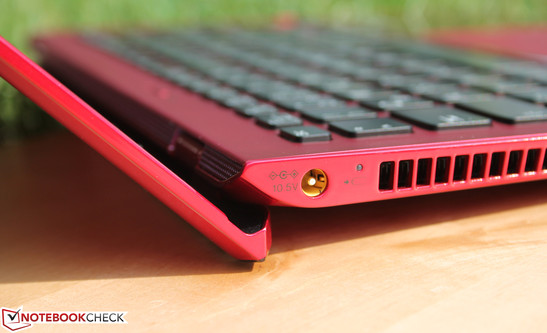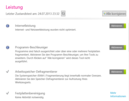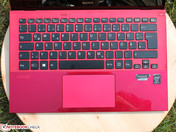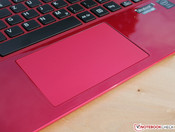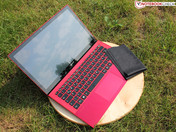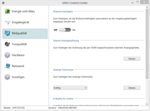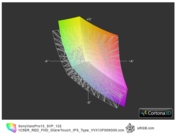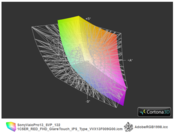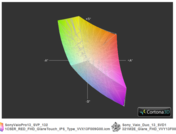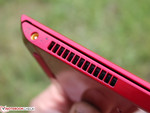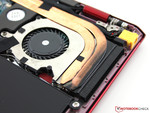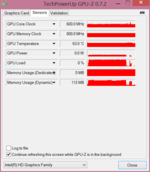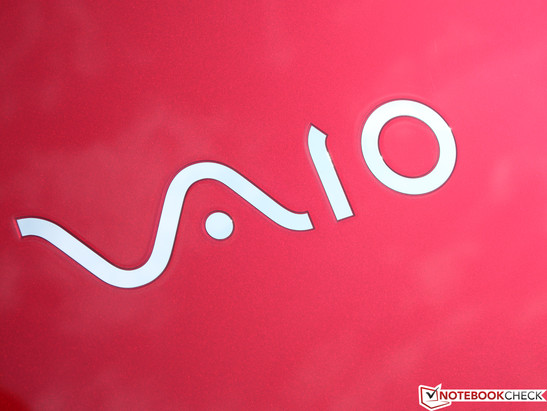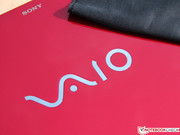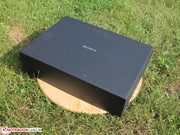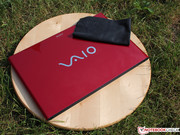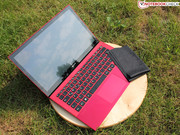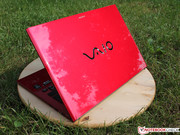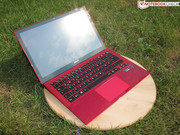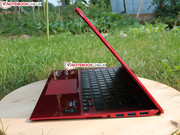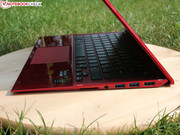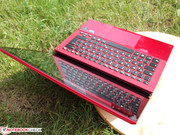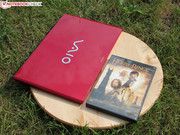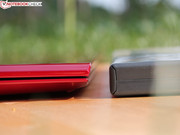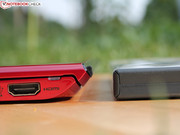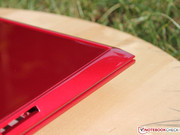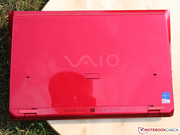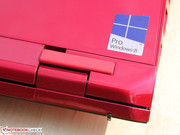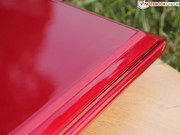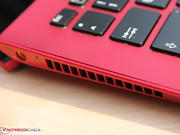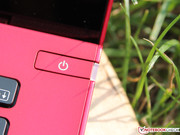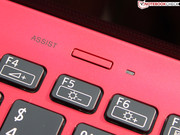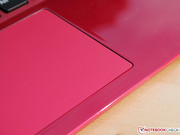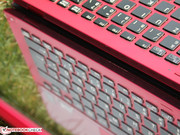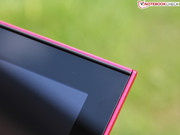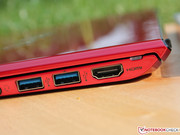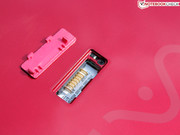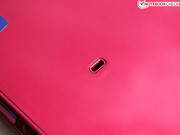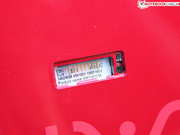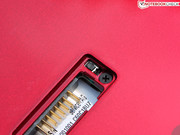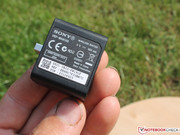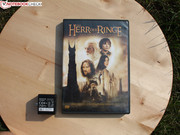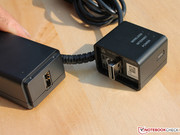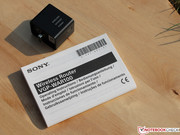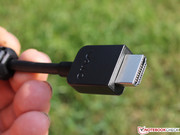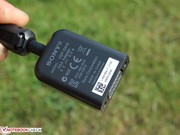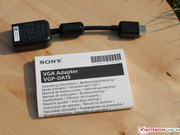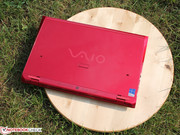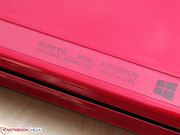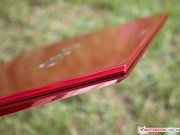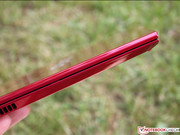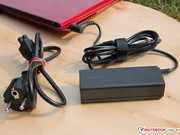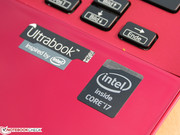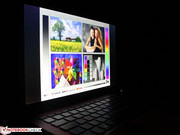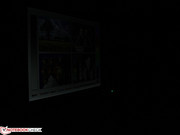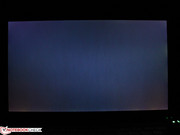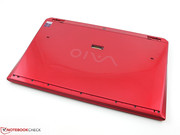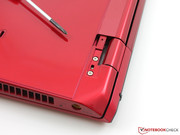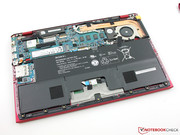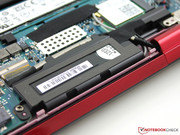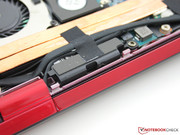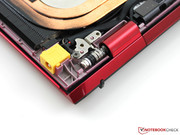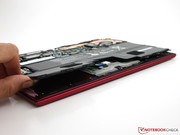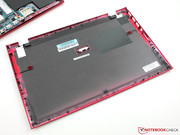Review Sony Vaio Pro 13 SVP-1321C5ER Ultrabook

For the original German review, see here.
Thanks to its low weight of just 860 grams (~1.9 pounds) we called the 11-inch Vaio Pro 11 a "Delicate Butterfly". The 13-inch sibling is just 200 grams (~0.44 pounds) heavier, which is enabled by the carbon fiber chassis. The Vaio 13 is also just 15 mm (0.6 inches) thick - plus an additional millimeter for the rubber feet. Thin and light is very nice, but why get a Red Edition of a business notebook with a glossy finish?
First of all, you can also get the Vaio Pro 11 and 13 in the standard matte colors black and silver. If you choose the red version, it is because you want to show that you are extroverted or just because you like the intense color. The price of our review unit is a hefty 2,000 Euros (~$2660) (configured in the Vaio Online Store).
The most interesting questions of this review: Can the slim chassis provide sufficient cooling for the Intel Core i7-4500U? After all, the base unit is just 10 millimeters (~0.4 inches) thin - at its thickest part. How much battery runtime and display quality can the manufacturer squeeze into the case? The latter was always on a very high level in the past; does Sony continue this tradition?
Competitors for the Red Baron are expensive consumer and business devices with high requirements in the design, choice of material (weight) and technology. The following 13-inch and 14-inch notebooks are the main rivals in our opinion; they are very light, very thin and have a high build quality. All of these devices have to make some compromises for the high requirements but are also considerably less expensive than our Vaio.
- · Samsung Series 9 900X3C (1,000 up to 1,500 Euros/~$1330 up to $1995)
- · Apple MacBook Air 13-inch 2013 MD760D/A (1,000 up to 1,300 Euros/~$1330 up to $1729)
- · Acer Aspire S7 391-73514G25aws (1,400 Euros/~$1862)
We also consider Lenovo's ThinkPad X1 Carbon (14-inch) and Asus' Zenbook Prime UX31A-C4027H Touch as high quality alternatives, but both of them are almost 500 grams (~1.1 pounds) heavier.
Case
While the Vaio Pro 11 left a very modest impression with its matte surfaces, this cannot be said about the Red Edition. If you choose the glossy version you do not want to get lost in the masses but deliberately attract attention. Sony's interpretation of the color is even more comprehensive: "Experience the ultimate craftsmanship that defines the heart and soul of a Vaio notebook". The bright color is supposed to symbolize the quintessence of the product line: "Get inspired by our passionate desire towards perfection with our VAIO Red Edition"
Be that as it may, the Red Edition is only available in the Vaio Online Store (not all regions), where you can also configure it. It is available for the Vaio Pro 11 & 13, as well as the Duo 13 and Fit 15. The manufacturer advertises that several layers of color are applied individually and then polished to realize the glossy appearance. Finally, all the parts are painted with a UV-coating (clear coat) to protect the color against fading.
Thin cases can be torsion resistant; the Zenbooks from Asus prove that. But these notebooks were heavy because of their aluminum unibodies weighing 1,465 grams (~3.2 pounds) (13.3-inch version), so we do not consider them as direct rivals. The same applies for the Lenovo ThinkPad X1 Carbon N3N34GE (1,516 grams/~3.3 pounds, carbon fiber), which is also equipped with a 14-inch display. All the direct competitors are heavier: Samsung Series 9 900X3C-A04DE (1,186 grams/~2.6 pounds); Apple MacBook Air 13 2013 (1,350 grams/~3.0 pounds); Acer Aspire S7 391-73514G25aws (1,268 grams/~2.8 pounds).
In return for the 1,066 grams (~2.4 pounds) you have to live with a very flexible carbon fiber chassis. Carbon is obviously a high-strength material, but with such a thin material thickness it is structurally not sufficient for a torsion resistant construction. The base unit starts to bend when you lift the opened Pro 13 at the palm rest with one hand. The display cover leaves a more stable impression. Only the Series 9 900X3C manages a higher stability at a similar weight with its aluminum chassis.
The display hinges sit very deep in the base unit; the whole rear part of the notebook is lifted by around one centimeter when you open the display. This is not really related to typing ergonomics but is necessary to attach the hinges to such a thin base unit. By the way, the case has no maintenance covers or visible screws on the bottom but it is still possible to open the case. Twelve screws are under the rubber feet (glued) and inside the port for the slice battery. You can lift the bottom cover after you loosen all the screws.
The display hinges are sufficiently firm. You can lift the display by around five centimeters with one finger before the force gets too strong and you have to use your second hand to hold the base unit down. The hinges cannot avoid a slight bouncing of the display, but it is still bearable unless you want to use touch inputs.
Connectivity
At a first glance, the Pro 13 does not have more ports than the competition. The two USB 3.0 ports and the HDMI port are too close to each other. Bulky connectors, memory sticks or HDMI-to-DVI adaptors, for instance, block the adjacent ports. Except for the MacBook Air 13 (mini DisplayPort/Thunderbolt) all rivals have a micro HDMI port and Samsung's Series 9 also comes with a mini VGA port. We find a connector and fixation points for an additional slice battery (long-term battery VGP-BPSE38) at the bottom. Such an additional battery is also available for the Aspire S7 391 (laborious with a cable connector).
Communication
Intel's Wireless-N 7260 (b/g/n) adaptor cannot really convince us, the range is not even 15 meters (~49 feet). The Vaio Duo 13 (Broadcom adaptor) had the same problems maintaining the connection in this environment (indoors and outdoors). Our Pro 13 has at least the full signal strength at the 10 meters (~33 feet) measuring point upstairs, but the connection to the Fritz!Box router (50% transmitting power) is lost outdoors at the 15 meter mark. Some notebooks, even low-cost devices, have a range of up to 40 meters (~131 feet). All review units, except for the Duo 13, at least managed a stable connection up to the 15-meter measuring point.
A UMTS module is not available for the Pro 13 and Sony does not offer the option in its shop. In return you get an Ethernet port for the traditional wired network. This port is not located on the device but at the provided wireless router (more information in the Accessories section).
The camera (1,280x720 pixels) is not suited for pictures or even videos; the quality is too bad even in daylight. Pictures, even close-ups, appear blurry and without contours. Considering the premium requirements and the price of the notebook, the mediocre webcam is inappropriate.
Security/Software
Except for the TPM module (has to be activated in BIOS: PC Off, Assist-button, then F2) and Intel's Anti-Theft technology there are no typical security features that we expect from a business notebook, for example a fingerprint reader or a Kensington Lock. The BIOS has no management features for the hardware apart from WLAN-, USB-, card reader- and TPM-On/Off.
Vaio Care combines all tools and settings for the hard- and software; it can be accessed via the Assist-button. Here you can find the hardware settings (Control Center: e.g. permanent illumination of the keyboard), the service contacts and the user guide.
Our review unit was equipped with a trial version of McAfee Security; you can get the Pro 13 with 1-, 2- and 3-year licenses for Internet Security or Total Protection (McAfee) in the online store. The same applies for Adobe Lightroom, Adobe Creation (several versions) or Microsoft Office 2013 (several versions).
Accessories
The box contains the wireless router VGP-WAR100 (10/100 Mbit/s RJ45), which is powered by the PSU. You do not even need a password via WPA button; this is very useful when the user occasionally wants to share the network with other devices. Sony specifies the range at 10 meters (~33 feet) and recommends using a maximum number of five devices at the same time. We have the same limited range with the VGP-WAR100 as we had with the Fritz!Box (10 meters upstairs: four bars; 15 meters (~49 feet) outdoors: no connection).
A VGA-dongle was already in the box of the Duo 13. After that, there is only a cleaning cloth, unfortunately a much-needed accessory.
Warranty
You automatically get a 2-year warranty when you purchase the notebook in the Vaio Store. Customers can configure the Care Pack according to their needs. Sony offers a 36-month warranty for 90 Euros (~$120); this includes Pick-up and Repair service on business days as well as an immediate phone support.
Input Devices
Keyboard
The keyboard has a bouncy keystroke, a limited travel and a very firm pressure point. Typing on the flat keys is not enjoyable; the problem is the spongy keystroke. The chassis is just too thin to compensate the stroke of heavy hands. As a result it can be, depending on the force, pushed in. This is a real drawback for frequent writers due to the lightweight construction. The keyboard has a one-stage illumination, a very useful feature for dark environments. We really liked the layout with the separated arrow keys and the large Return- and Shift-key.
Touchpad
The large touchpad (Synaptics ClickPad V0.0) has an average pressure point, but only in the bottom half of the touchpad. The required force makes clicking inconvenient. However, the matte surface does have good gliding capabilities. There are no separate mouse buttons but it can recognize a left or right click according to the position of the fingers. The sensitivity is very good even in the peripheral zones and the touchpad supports the usual multi-touch gestures.
Touch Panel
The Vaio is equipped with a touch panel; it is standard for the device and there is no anti-reflective version (at least for the Red Edition). Handling is very convenient and fast without calibration. The only problem is the bouncing display (even with the maximum opening angle). On the other hand it is very stable; the Pro 13 can be lifted at the cover without any display distortions.
Display
The IPS panel (Panasonic VVX13F009G00) has a Full HD resolution (1920x1080 pixels); the pixel density of 165 ppi is quite high for a 13-inch notebook. Sony does not offer other displays besides the multi-touch panel. An anti-reflective protective film, similar to the Duo 13, is not available for the Pro 13.
Sony's Triluminos display has a high average brightness of 363 cd/m². We even measure 399 cd/m² at some spots; the results remind us of the Duo 13. The displays are identical in regard to the brightness and color space (apart from measuring tolerances). The display brightness can be adjusted via the brightness sensor but we deactivated it for our measurements (and also the battery runtime tests). The sensor enables an adequate brightness adjustment depending on the ambient light.
| |||||||||||||||||||||||||
Brightness Distribution: 84 %
Center on Battery: 353 cd/m²
Contrast: 679:1 (Black: 0.52 cd/m²)
ΔE ColorChecker Calman: 3.35 | ∀{0.5-29.43 Ø4.78}
ΔE Greyscale Calman: 2.76 | ∀{0.09-98 Ø5}
65% AdobeRGB 1998 (Argyll 1.6.3 3D)
62.5% AdobeRGB 1998 (Argyll 3D)
77.2% sRGB (Argyll 3D)
64% Display P3 (Argyll 3D)
Gamma: 2.4
CCT: 6101 K
With a black value of 0.52 cd/m² and a contrast ratio of 672:1, the color presentation cannot completely keep up with the OptiContrast display of the Duo 13 (Duo 13: 0.32 cd/m²; 1,151:1) and Sony does not advertise OptiContrast displays on the website of the Vaio Pro 11/13.
We calibrate the Triluminos display (reference sRGB) and start with the coverage of the two most important color spaces. The Pro 13 covers sRGB by 94% and AdobeRGB by 65%, this should be sufficient for most professional users.
We use the CalMAN software and a photo spectrometer to determine the professional capabilities of the display before (ex-works) and after the calibration. The grayscale presentation is very good ex-works, a DeltaE(2000) value below four means that the human eye cannot see the difference between sRGB patterns and the native patterns (color charts). The calibration can even improve this result; the DeltaE(2000) value drops below 2.0.
The calibration showed no significant improvements in regard to the saturation, but the color presentation was already quite good. ColorChecker determines an average DeltaE(2000) value of 3.68 (ex-works) or 3.35 (calibrated), respectively.
Despite the high brightness of almost 400 cd/m², the display has problems with direct sunlight. The strong reflections are annoying, no matter if you are in the shade or in the sunlight. Nevertheless, the readability of the display content is still better compared to many glossy notebook displays with a low contrast ratio. Among the competitors, Samsung's Series 9 900X3B has the advantage of the anti-reflective display surface and the higher brightness (430 cd/m²; Non-Touch). The Aspire S7-391 is similarly bright but significantly reduces the display brightness to 165 cd/m² on battery power. The glossy display of the MacBook Air 13 Mid-2013 reaches 277 cd/m².
The Pro 13 has excellent viewing angles: You can see a consistently bright and colorful picture from every position and colors do not invert. The competitors are also equipped with IPS panels and can keep up in this category (Samsung PLS). One exception is the X1 Carbon with a TN panel.
Performance
We chose the Core i7-4500U (1.8 GHz) configuration of the Pro 13 for our review. Besides that you can only select the Haswell processor i5-4200U (2x 1.6 GHz). Storage options are also limited; the 13-inch notebook only has one mSATA port. We chose the 512 GB version from Toshiba (HG5d THNSNH512GDNT) but a smaller 256 GB drive is also available. The memory is soldered onto the mainboard, there is no alternative to the eight GB DDR3L-SDRAM (1600 MHz).
Processor
We selected the processor and fan setting Performance (alternatives: Standard, Silent) in the Vaio Control Center. We also deactivated the energy-saving settings, for battery power as well, in the Intel HD Graphics driver. The i7-4500U is slightly behind the competitors (+8 up to 22%), at least in the Multi-Thread tests.
Due to the lower nominal clock, our CPU cannot beat processors like the i7-3517U (1.9 GHz, Zenbook UX31A), but why does the Core i5-3427U (1.8 GHz, ThinkPad X1 Carbon) have an advantage of 11%? The reason is the limited use of the Turbo Boost feature under continuous CPU load (see screenshots). We determine 2.7 GHz in the beginning but the clock is quickly reduced to 2.1 GHz. The mentioned X1 Carbon has a steady clock of 2.6 GHz.
The i7 executes the Single-Core tests with a constant Turbo clock of 2.7 GHz; our review unit can surpass the competitors (CPU Single 64-bit; 6 - 15%). The CB-R11.5 results are almost identical on battery power and sometimes even slightly higher (measuring tolerances).
System Performance
The system performance, determined by PCMark vantage and PCMark7, can surpass some competitors thanks to the fast Toshiba SSD, even the Apple MacBook Air 13 with the latest Haswell CPU. The Toshiba HG5d (512 GB) can set a new System Storage (PCMark 7) benchmark record; the competition falls behind by around 20%. The PCMark 7 overall score shows an advantage of up to 8%, older devices with an Ivy Bridge i7 (Zenbook UX31A) fall behind by four and up to 21%. The measurements confirm our subjective impression: The Vaio Pro 13 boots up in a few seconds and applications start almost instantaneously.
| PCMark Vantage Result | 11700 points | |
| PCMark 7 Score | 4740 points | |
Help | ||
Storage Solution
Let's have a closer look at the Toshiba SSD (HG5d THNSNH512GDNT, 512 GB). The mSATA version can keep up with the rivals in CrystalDiskMark's Read Test. The RAID configuration of two SSD's inside the Aspire S7 (+80%) can obviously not be beaten and Apple's SM0128F SSD in the Air 13 (+35%) seems to be a fast solution.
However, the read and write performance of small and spread blocks is much more important than large files in practice (sequential read/write tests). Among others we use the 4K-Read-Test; the SSD's from the X1 Carbon (SanDisk SD5SB2128G) and UX31A (ADATA XM11) can take the lead. However, the small advantage of just 10% is insignificant; the storage solution inside the Vaio Pro 13 is one of the fastest SSD's in ultra-light devices.
Graphics
Intel's HD Graphics 4400 is an integrated graphics solution. In combination with the Core i7-4500U it can use a Turbo range between 200 and 1,100 MHz. Thanks to additional shader-units it is faster than the similar structured HD Graphics 4000 of Ivy Bridge processors. The HD Graphics of our review unit benefits from the dual-channel memory configuration (soldered onto the mainboard). That is the theory, what about the benchmarks?
3DMark 2006 does not show a significant advantage over rivals with the HD 4000. The Air 13 with the HD Graphics 5000 and the 4250U is ahead by 17%. We also use the Vaio Duo 13 with the identical GPU to determine possible differences in the Turbo range. The HD 4400 is clocked at 200-1,000 MHz (dual-channel) and the Duo 13 can take the lead despite the alleged lower clock.
Cinebench OpenGL does not stress the CPU and shows that our HD 4400 is far behind the Duo 13 (+17%) and it is the same situation with all the other competitors. 3DMark 11 and 3DMark (2013) Cloud Gate indicate an even larger disadvantage for the Pro 13; the identical HD 4400 from the Duo 13 is ahead by 22 or 37%, respectively.
The reason for this unexpected weak performance of the Intel HD 4400 is the low clock. We can see the maximum 1,100 MHz at the beginning of the benchmark but the clock is reduced to 800 MHz after ten to 20 seconds and then levels off between 650 and 800 MHz. This happened during simple GPU benchmarks as well as gaming scenarios.
As long as you select the high performance setting in the Intel driver (energy saving Off), the performance is not reduced on battery power.
| 3DMark - 1280x720 Cloud Gate Standard Graphics (sort by value) | |
| Sony Vaio Pro 13 SVP-1321C5ER | |
| Apple MacBook Air 13 inch 2013 MD760D/A | |
| Sony Vaio Duo 13 SVD1321M2E | |
| 3DMark 11 - 1280x720 Performance (sort by value) | |
| Sony Vaio Pro 13 SVP-1321C5ER | |
| Samsung 900X3C-A04DE | |
| Apple MacBook Air 13 inch 2013 MD760D/A | |
| Sony Vaio Duo 13 SVD1321M2E | |
| 3DMark 06 Standard Score | 5196 points | |
| 3DMark 11 Performance | 791 points | |
| 3DMark Ice Storm Standard Score | 30843 points | |
| 3DMark Cloud Gate Standard Score | 3607 points | |
| 3DMark Fire Strike Score | 492 points | |
Help | ||
Gaming Performance
The gaming capabilities of the graphics solution are limited and the situation is even made worse by the low clock. The Vaio Duo 13 with a Core i5 and HD 4400, for instance, has a performance advantage between 12 and 45% in the latest games.
We also show the entry-level GT 720M (Asus F75VC) for comparison. Games run around 60% faster on the Nvidia GPU (average), but even this is not sufficient for high details and resolutions. For more information on the gaming capabilities of the new Haswell GPU's also see our review: Intel HD Graphics 4600: There is more in it than you think.
| Fifa 13 - 1366x768 High AA:2xMS (sort by value) | |
| Sony Vaio Pro 13 SVP-1321C5ER | |
| Samsung 900X3C-A04DE | |
| Sony Vaio Duo 13 SVD1321M2E | |
| Asus F75VC-TY088H | |
| Medal of Honor: Warfighter - 1024x768 Low Preset AF:2x (sort by value) | |
| Sony Vaio Pro 13 SVP-1321C5ER | |
| Sony Vaio Duo 13 SVD1321M2E | |
| Asus F75VC-TY088H | |
| Dead Space 3 - 1366x768 Medium Preset (sort by value) | |
| Sony Vaio Pro 13 SVP-1321C5ER | |
| Sony Vaio Duo 13 SVD1321M2E | |
| Asus F75VC-TY088H | |
| low | med. | high | ultra | |
|---|---|---|---|---|
| Fifa 13 (2012) | 72 | 60 | 34 | |
| Medal of Honor: Warfighter (2012) | 22 | 16 | 13 | |
| Dead Space 3 (2013) | 46 | 27 | 22 | 11 |
| SimCity (2013) | 33 | 14 | 11 |
Emissions
System Noise
Sony preselected the Silent fan-/processor-mode and the Balanced setting for the HD Graphics ex-works to deliver a quiet subnotebook despite the powerful hardware. The result is a nearly silent device with just 30 dB(A), the fan is slightly louder during idle and under load with 31 dB(A) if you select the according Performance settings. That is certainly not a high value but still slightly audible.
Is the cooling sufficient under maximum load or will we see reduced performance or even throttling during our stress test? First of all, we measure a maximum noise level of a clearly audible 47 dB(A) during our stress test and during 3DMark 2006. This noise is very annoying; the competitors are usually quieter during the stress test and the results are similar or even lower during idle: Series 9 900X3B (31/37 dB(A) idle/stress test); MacBook Air 13 Mid 2013 (29/45), Acer Aspire S7-391 (31/47); Asus UX31A (30/41).
Noise level
| Idle |
| 29.6 / 29.9 / 31.2 dB(A) |
| Load |
| 47.1 / 47.4 dB(A) |
 | ||
30 dB silent 40 dB(A) audible 50 dB(A) loud |
||
min: | ||
Temperature
We measured the surprisingly low idle surface temperatures (below 31 degrees/97.8 Fahrenheit on average) with the activated energy-saving mode (GPU Balanced, fan-/processor-mode Balanced). The palm rest stays very cool all the time. The reason: Beneath it is just the thin battery.
We determine the highest temperatures under load at the back of the Pro 13; here we can find the components and the cooling. We measure up to 66 degrees at the bottom and 48 degrees (150.8 and 118.4 Fahrenheit) at the top during our stress test. The keyboard is also affected since it sits very far behind in the chassis. The Vaio Pro does not have any fan exhaust at the bottom you could block so you can use it on your lap; the fan exhaust is located at the back and gets the air through a barely visible cover between the base unit and the display cover (between the hinges).
The CPU clock is reduced to 900 MHz (throttling) when the CPU temperature reaches 80 degrees Celsius (176 Fahrenheit) to protect the hardware and the graphics card leveled off at around 650 MHz. This is the result of our stress test, not a very realistic scenario but we use it to check the cooling under maximum load (Prime95 and FurMark at the same time) for at least two hours.
The performance was not reduced when we only ran the Prime95-CPU Test (1.8-1.9 GHz); the clock was not below the nominal clock but the situation changes during FurMark: The clock slowly fluctuates between 200, 850 and 1,100 MHz. Gaming shows that the Vaio Pro 13 is also affected by reduced GPU performance: The HD 4400 levels off between 650 and 800 MHz in MoH: Warfighter (high settings).
Are the rivals also affected by throttling? Only the ThinkPad X1 Carbon (throttling @ 1.1 GHz) shows a significant performance reduction in our stress test. The other competitors only disable the Turbo Boost, which is not a case of throttling (Acer Aspire S7 391, Asus UX31A). The Vaio Duo 13 with a Haswell-i5 also leveled off at its nominal clock and the most consistent device was the MacBook Air 13 Mid 2013 (Turbo active, 2.3 GHz).
(-) The maximum temperature on the upper side is 48 °C / 118 F, compared to the average of 35.9 °C / 97 F, ranging from 21.4 to 59 °C for the class Subnotebook.
(-) The bottom heats up to a maximum of 66.2 °C / 151 F, compared to the average of 39.3 °C / 103 F
(+) In idle usage, the average temperature for the upper side is 30.3 °C / 87 F, compared to the device average of 30.8 °C / 87 F.
(+) The palmrests and touchpad are cooler than skin temperature with a maximum of 29.5 °C / 85.1 F and are therefore cool to the touch.
(±) The average temperature of the palmrest area of similar devices was 28.2 °C / 82.8 F (-1.3 °C / -2.3 F).
Speakers
The speakers are behind a small cover on the back of the base unit. They consist of three individual parts for the high, low and medium tones. The effort pays off; even high volumes result in a very clear sound experience without distortions. However, there is no bass at all. The maximum volume is very high for such a small subnotebook and you can easily use it to fill a small room with the sound.
Sony's Vaio Audio tool provides different profiles for music and movies and switching between the presets makes sense (ClearAudio +). The sound volume, the surround effect and the clarity of the sound are convenient. The Array microphone is above the webcam and is well suited (low noise) for applications like Skype.
Energy Management
Power Consumption
The very long idle runtime of 16:42 hours already suggests that the thin Haswell system can be very energy efficient. We measure 2.7 up to 7 Watts during idle, a very low result. None of the competitors can match this consumption. The seven Watts were measured with the maximum display brightness of almost 400 cd/m²! MacBook Air 13 (5-12 Watts), Aspire S7 (7-11 W), the X1 Carbon (6-12 W) and Asus UX31A (6-12 W) consume more energy during idle with the minimum display brightness.
Reason for this frugal behavior: The chipset is now integrated into the CPU package and the idle clock of the HD 4400 was reduced from 350 to 200 MHz. Finally the TDP of the Haswell CPU's in this category was lowered from 17 (Ivy Bridge) to 15 Watts. The very low idle consumption of the new Haswell CPU's seems to have become standard for small devices. The recently reviewed Vaio Duo 13 (i5-4200U) only consumed 3.3 up to 6.6 Watts with a similar display brightness.
The low TDP also affects the load consumption. We measured 31 Watts for the Duo 13, the maximum consumption of the Vaio Pro 13 is just 15 Watts in our stress test (32 or 24 Watts for a very short time) due to the already mentioned CPU throttling (see Temperature-section). This is also the reason for the higher medium-load consumption (3DMark 2006) of 24 Watts. The old Ivy Bridge generation consumed around 35 Watts in our stress test (without throttling).
The 40-Watt power supply unit delivers sufficient energy; it is the same PSU we already know from the Duo 13. You can also recharge your smartphone at the 5 Volt USB port.
| Off / Standby | |
| Idle | |
| Load |
|
Key:
min: | |
Battery Runtime
Battery runtimes are heavily affected by the energy-saving modes (processor/fan: Silent, HD Graphics: Energy saving). They were active for our idle test but obviously not for the load scenario. The frugal notebook manages 16:42 hours during idle with the minimum display brightness and deactivated wireless connections. This is the theoretical maximum runtime.
Continuous load of the Battery Eater Classic Test results in a minimum battery runtime of 2:02 hours. All settings were set to Performance with the maximum display brightness (ambient light sensor deactivated).
Far away from the manufacturers' specification of eight hours is the WLAN runtime of just 5:16 hours. The wireless connection was activated and the brightness was adjusted to 150 cd/m² (reduced by three steps). Energy-saving settings for the CPU (Silent), GPU (energy saving) and display (40 Hz) were also active.
The competition can keep up with these results and the MacBook Air 13 Mid 2013 even manages a significantly higher WLAN runtime. Not a real surprise since it is 300 grams (~10.6 ounces) heavier and has a 50 Wh battery; our Vaio Pro 13 is only equipped with a 36 Wh battery. The heaviest rivals Asus UX31A (1,465 grams/~3.2 pounds, 50 Wh) and X1 Carbon (1,347 grams/~3.0 pounds, 45 Wh) do not manage longer runtimes despite the larger batteries, quite the contrary actually. This is a good result for the frugal Haswell processor and the runtime-weight ratio.
- · Samsung Series 9 900X3B (7:58 h/4:56 h, idle/WLAN)
- · Acer Aspire S7 391 (6:39 h/3:29 h)
- · MacBook Air 13 Mid-2013 (13:28 h/10:23 h)
- · Asus UX31A (8:58 h/4:20 h)
- · Lenovo ThinkPad X1 Carbon (8:56 h/6:07 h)
Verdict
Light, thin and elegant. Samsung Series 9, Apple MacBook Air 13, Acer Aspire S7 391 and Lenovo ThinkPad X1 Carbon – all devices make compromises to meet these requirements. The Vaio 13 Pro is the lightest Ultrabook (1,066 grams/~2.4 pounds) within this competition; the just 10 mm (0.4 inches) thick base results in a reduced keyboard quality and problems with the torsion resistance. The case material of carbon fiber is unbreakable but still flexible. Some aluminum unibodies of the rivals are stiffer but also heavier.
We will start with the good aspects: The very bright touch display convinces us with the excellent color accuracy ex-works (94% sRGB). Thanks to its Full HD resolution and the wide viewing angles (IPS) it is also suited for professional use (graphics, programming, design). The glossy touch panel might be annoying but is always an advantage on the go (e.g. plane, train, presentation). Contrary to the Vaio Duo 13 there is no digitizer pen.
The mobility is quite limited at a first glance (5:16 hours WLAN Test) but no competitor can match the runtime-weight ratio of the Vaio Pro 13. Port variety and expandability are limited (case can be opened, battery is fixed, RAM is soldered, mSATA storage), but the provided mini wireless router is a very useful accessory.
We had problems with the WLAN range; the Vaio lost the connection with a distance of 15 meters (~49 feet/even with the provided mini wireless router). This was also a problem of the Duo 13, although it was even worse. We suspect insufficient wireless antennas (2 in case of the Intel Wireless-N 7260).
The performance reduction during simple CPU benchmarks and gaming (and especially during our stress test) raises the question why you should choose the expensive Core i7 when you don't even get the performance of a Core i5 (see CB R11.5 Multi, ThinkPad X1 Carbon +11%). It is the same situation with the weak benchmark results of the HD Graphics 4400. The answer: Because the performance of the 15 Watts processor (TDP) would be even worse (lower nominal clock of an i5-4250U, for instance).
Performance enthusiasts will certainly not be satisfied with this situation, but if you mainly use the notebook on the go and only occasionally use the Pro 13 in the High Performance mode you will be satisfied: The compromise between efficiency on the go and performance on the desk is reasonable. After all, the Turbo Boost is working except for our stress test, only the GPU cannot really keep up.




